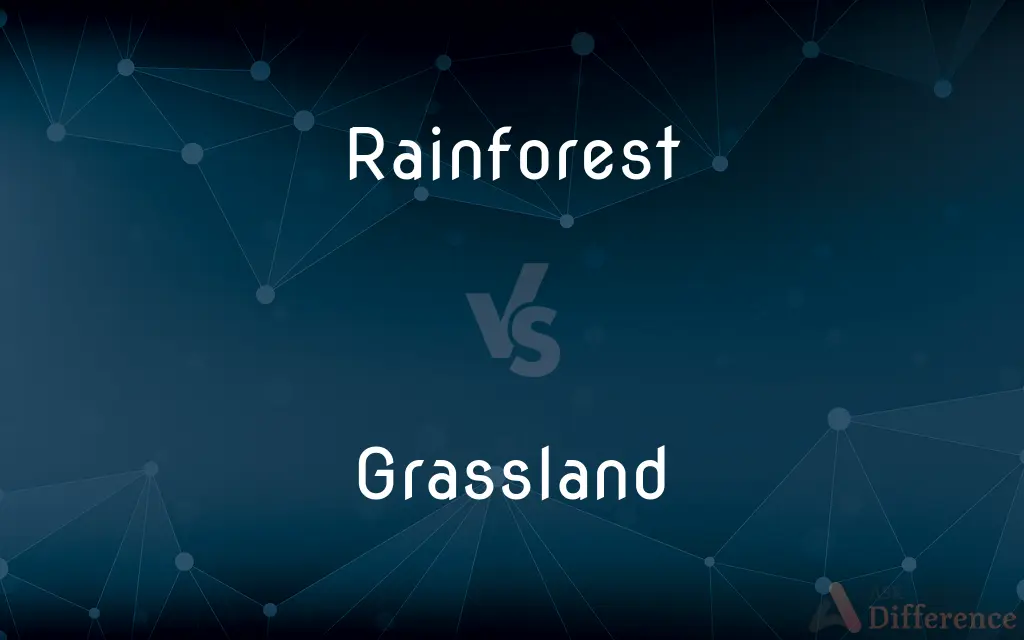Rainforest vs. Grassland — What's the Difference?
By Maham Liaqat & Fiza Rafique — Updated on March 26, 2024
Rainforests are dense, wet forests with high biodiversity, thriving in warm, moist climates, whereas grasslands are open, spacious areas dominated by grasses, found in regions with more moderate to low rainfall.

Difference Between Rainforest and Grassland
Table of Contents
ADVERTISEMENT
Key Differences
Rainforests are characterized by their dense canopy of tall trees and a warm, moist climate that supports a diverse range of plant and animal life. These ecosystems are vital for their role in oxygen production and carbon dioxide absorption, making them crucial in the fight against climate change. On the other hand, grasslands, with their open landscapes dominated by grasses and occasional trees, are adapted to a variety of climates, from temperate to tropical regions. They support a rich biodiversity, especially of herbivores and their predators, and are important for agriculture and grazing.
While rainforests receive a high amount of rainfall, typically over 2000 mm annually, which sustains their lush vegetation and diverse ecosystems, grasslands experience moderate to low rainfall, ranging from 250 to 1500 mm a year. This difference in precipitation shapes the distinct plant and animal life found in these biomes, with rainforests housing thousands of tree species and grasslands being dominated by grass species, which can quickly regenerate after events like fires.
Rainforests play a crucial role in regulating the global climate by sequestering large amounts of carbon dioxide, whereas grasslands are essential for soil conservation and act as carbon sinks as well, though to a lesser extent. Both ecosystems are under threat from human activities such as deforestation, agriculture, and climate change, impacting their biodiversity and ecological functions.
The biodiversity in rainforests is among the highest on Earth, with millions of species of plants, animals, and insects, many of which are yet to be discovered. Grasslands, while not as diverse in species as rainforests, are home to unique species adapted to open, less dense environments, including many types of grasses, wildflowers, and large herbivores such as bison and antelope.
Rainforests offer ecosystem services like water cycle regulation, climate moderation, and habitat for indigenous people who rely on them for their livelihoods. Grasslands, though less dense, provide vital services such as grazing lands for livestock, habitat for migratory birds, and preservation of certain traditional ways of life for people around the world.
ADVERTISEMENT
Comparison Chart
Dominant Vegetation
Tall trees and dense underbrush
Grasses with few trees or shrubs
Climate
Warm and moist
Can vary from cold to warm, generally drier
Biodiversity
Very high, including many unique species
High, especially in herbivores and grass species
Rainfall
Over 2000 mm annually
250 to 1500 mm annually
Ecological Role
Carbon sequestration, oxygen production
Soil conservation, carbon sink
Compare with Definitions
Rainforest
A dense forest rich in biodiversity, typically found in tropical areas.
The Amazon Rainforest is vital for the planet's climate regulation.
Grassland
A biome dominated by grasses, with few trees or shrubs.
Grasslands cover vast areas of the Earth, providing habitats for many species.
Rainforest
Characterized by high rainfall and humidity.
Rainforests act as the Earth's lungs, producing vast amounts of oxygen.
Grassland
Adapted to a range of climates, from temperate to tropical.
Grasslands in Africa are home to iconic species like lions and elephants.
Rainforest
Home to a wide variety of plant and animal species.
Rainforests are biodiversity hotspots, harboring countless species.
Grassland
Faces threats from agriculture and urbanization.
The conversion of grasslands into farmland reduces biodiversity.
Rainforest
Threatened by deforestation and climate change.
Protecting rainforests is crucial for maintaining biodiversity.
Grassland
Important for agriculture and grazing.
Grasslands are crucial for supporting the world’s livestock.
Rainforest
Provides ecosystem services like climate regulation.
The ecological balance of rainforests affects global climate patterns.
Grassland
Acts as a carbon sink, aiding in climate regulation.
Conserving grasslands is important for carbon sequestration efforts.
Rainforest
A dense evergreen forest with a minimum annual rainfall of approximately 180 centimeters (71 inches). Rainforests are found chiefly in the tropics but also occur in temperate regions, where the rainfall amount is somewhat lower.
Grassland
Grasslands are areas where the vegetation is dominated by grasses (Poaceae). However, sedge (Cyperaceae) and rush (Juncaceae) can also be found along with variable proportions of legumes, like clover, and other herbs.
Rainforest
Rainforests are characterized by a closed and continuous tree canopy, moisture-dependent vegetation, the presence of epiphytes and lianas and the absence of wildfire. Rainforest can be classified as tropical rainforest or temperate rainforest, but other types have been described.
Grassland
An area, such as a prairie or meadow, of grass or grasslike vegetation.
Rainforest
A forest in a climate with high annual rainfall and no dry season.
Grassland
An area dominated by grass or grasslike vegetation.
Rainforest
A forest with heavy annual rainfall
Grassland
Land where grass or grasslike vegetation grows and is the dominant form of plant life
Common Curiosities
What role do grasslands play in the ecosystem?
Grasslands support herbivores, act as carbon sinks, and are important for agriculture.
What defines a rainforest?
A rainforest is defined by its dense tree canopy, high rainfall, and warm temperatures, supporting a diverse ecosystem.
How do grasslands differ from forests?
Grasslands are dominated by grasses with fewer trees, adapted to environments with less rainfall than forests.
Can grasslands be found in tropical areas?
Yes, tropical grasslands, or savannas, exist and are characterized by seasonal rains and diverse fauna.
Are rainforests or grasslands more biodiverse?
Rainforests generally have higher biodiversity, but grasslands also support unique ecosystems.
What is the biggest threat to rainforests?
Deforestation, driven by logging, agriculture, and urban expansion, is the biggest threat.
How do grasslands contribute to carbon sequestration?
Through the growth of grasses that absorb CO2 and the soil that stores carbon.
What types of animals thrive in grasslands?
Large herbivores like bison, antelope, and numerous bird species are well-suited to grassland habitats.
What agricultural practices are common in grasslands?
Primarily grazing, but also crop cultivation in areas where the soil is suitable.
Why are rainforests important?
They are crucial for biodiversity, climate regulation, and providing oxygen.
What is being done to protect these biomes?
Conservation efforts include protected areas, sustainable land use practices, and restoration projects.
How does climate change affect these biomes?
It alters precipitation patterns and temperatures, impacting species distribution and ecosystem health.
What is unique about the flora in rainforests?
Rainforests have thousands of tree species and undergrowth plants adapted to low light.
How do humans use rainforests?
For resources like timber and medicinal plants, and through tourism and research.
How do rainforests affect the global water cycle?
They contribute to the global water cycle through evapotranspiration, releasing water vapor into the atmosphere.
Share Your Discovery

Previous Comparison
Disadvantage vs. Drawback
Next Comparison
Caravel vs. CarrackAuthor Spotlight
Written by
Maham LiaqatCo-written by
Fiza RafiqueFiza Rafique is a skilled content writer at AskDifference.com, where she meticulously refines and enhances written pieces. Drawing from her vast editorial expertise, Fiza ensures clarity, accuracy, and precision in every article. Passionate about language, she continually seeks to elevate the quality of content for readers worldwide.
















































